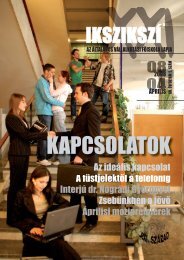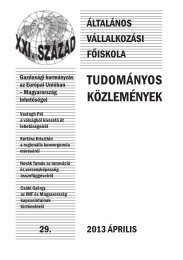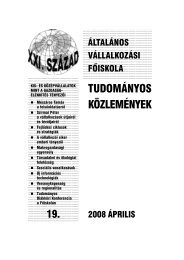Tudástársadalom, vállalkozások, Európa - Ãltalános Vállalkozási ...
Tudástársadalom, vállalkozások, Európa - Ãltalános Vállalkozási ...
Tudástársadalom, vállalkozások, Európa - Ãltalános Vállalkozási ...
Create successful ePaper yourself
Turn your PDF publications into a flip-book with our unique Google optimized e-Paper software.
12345678901234567890123456789012123456789012345678901234567890121234567890123456789012345678901212345678901234567890123123456789012345678901234567890121234567890123456789012345678901212345678901234567890123456789012123456789012345678901231234567890123456789012345678901212345678901234567890123456789012123456789012345678901234567890121234567890123456789012312345678901234567890123456789012123456789012345678901234567890121234567890123456789012345678901212345678901234567890123123456789012345678901234567890121234567890123456789012345678901212345678901234567890123456789012123456789012345678901231234567890123456789012345678901212345678901234567890123456789012123456789012345678901234567890121234567890123456789012312345678901234567890123456789012123456789012345678901234567890121234567890123456789012345678901212345678901234567890123103Multi-component analysis (MCA)Multi-component analysis is usually applied as an additional indicator if we also are to take intoaccount environmental and social effects that are difficult to express numerically. It can help in selectingthe optimal investment from different projects. A fundamental requirement for the chosen erffects is thattheir weighting should be appropriately justified, as this can largely influence objectivity. One of thetopical issues of our day, for example, is energy supply. In building a power plant, beyond the costs, theexamination of environmental effects and the plant’s ability to generate jobs are also factors of primarysignificance. In the event of having to choose between two projects in which the above factors carrydifferent weight, the one with the more favourable value is worth implementing.Table 2MULTI-COMPONENT ANALYSISDenomination Costs Environmental Job creation RatingeffectcapacityInvestment A 3 5 4 0.65x3+0.30x5+0.05x4=3.65Investment B 4 2 5 0.65x4+0.30x2+0.05x5=3.45In the above example, let us assume that the costs are 65 pc, the environmental effects are 30 pc, thejob creation capacity is 5 pc, while the value of these effects is weighted from 1 to 5, where 1 is theweakest and 5 is the most favourable value. In our example the implementation of Investment A isadvisable.Sensitivity and risk analysisThe aim of sensitivity analysis is selecting the critical variables whose positive or negative changeshave a major impact on the return on the investment. In selecting the critical variables, we must act withthe utmost circumspection, as there are no standard solutions. It is a basic rule that the variables must beindependent of each other, as any internal dependence might lead to the distortion of the result. Forexample, if we also include the operational costs and the costs of the services in the critical variables,then the operational costs will also likely include the costs of the services, so the latter have to be takenout from the critical variables. After the critical variables have been selected and the direction of theirchanges is determined, the probability of the occurance of the change must also be determined (riskanalysis). After determining the probability distribution of the critical variables, the probability distributionof the net present value and the internal rate of return can be calculated.Scenario analysisThough scenario analysis cannot replace sensitivity- and risk-analysis, its examination can be usefulwithin a given hypothesis. In the case of the previously selected critical variables, we determine theextreme (optimistic and pessimistic) values within the probability distribution domain. In this case it isunnecessary to precisely determine probability distributions. Finally we calculate the internal rate ofreturn.









